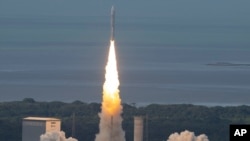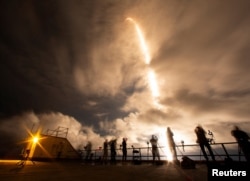Helium leaks have been a major problem for spacecraft and rockets.
Recent reports about Boeing’s Starliner and SpaceX’s Polaris Dawn mission have involved problems controlling helium. Recently, the Starliner had a helium leak in a propulsion system. Polaris Dawn also had helium issues on its ground equipment.
Helium leaks have affected past missions including the Indian Space Research Organization's Chandrayaan 2 and the European Space Agency’s Ariane 5.
Recently, Reuters news agency explored why spacecraft and rockets use helium, and why it can cause problems:
Why is helium used on spacecraft?
Helium is inert, meaning it does not chemically react with other substances. It also does not burn. Helium’s atomic number is 2, making it the second lightest element after hydrogen.
Rockets need to reach exact speeds and altitudes to maintain their orbits. Heavier rockets need more energy to fly and use more fuel. They also require more powerful engines, which are costlier to develop, test, and maintain.
Helium has an extremely low boiling point of -268.9 degrees Celsius. This means that it remains a gas even in extremely cold environments like space. That is an important quality because many rocket fuels are stored at low temperatures.
Helium is not toxic. But it cannot be breathed on its own because it displaces oxygen. Humans need oxygen to live.
How is helium used in rockets?
Because of its special qualities, helium is used to pressurize fuel tanks. It helps ensure fuel flows to the rocket's engines without stopping. Helium is also used for cooling systems.
As fuel and oxidizer are burned in the rocket's engines, helium fills the resulting empty space in the tanks, maintaining the correct pressure inside.
Because it is non-reactive, it can safely mix with other contents in the tanks.
Is helium more likely to leak?
Helium’s small atomic size and low molecular weight mean its atoms can escape through small spaces or seals in storage tanks and fuel systems.
However, because there is very little helium in the Earth's atmosphere, leaks can be easily detected. This makes the gas important for identifying possible problems in a rocket or spacecraft's fuel systems.
In May, hours before Boeing's Starliner spacecraft made its first attempt to launch an astronaut crew, sensors inside the spacecraft detected a small helium leak. The American space agency NASA spent several days studying the leak before deciding it was low risk.
Additional leaks were detected in space after Starliner launched in June. Such discoveries played a part in NASA's decision to bring Starliner back to Earth without its crew.
As a result, two NASA astronauts who flew to the International Space Station aboard a Starliner capsule will need to return to Earth on a SpaceX vehicle early next year.
The frequency of helium leaks across space-related systems, some engineers say, has shown an industry-wide need for innovation. Innovation is needed in the design of valves and the mechanisms that tighten them. A valve is a mechanical device that controls the flow of a gas or fluid.
Can another gas be used?
Some rocket scientists have experimented with gases such as argon and nitrogen, which are also inert and can sometimes be less costly. Helium, however, is much more common in the space industry.
In Europe's new Ariane 6 rocket, designers replaced the helium that was used in the rocket’s predecessor Ariane 5. The Ariane 6 has a new pressurization system. The new system changes a small amount of liquid oxygen and hydrogen propellants to gas, which then pressurizes those fluids for the rocket engine.
That system failed in space, however, during the final part of Ariane 6's otherwise successful launch in July. The failure of the new system added to the international rocket industry's list of pressurization difficulties.
I’m John Russell.
Nivedita Bhattacharjee reported on this story for Reuters. John Russell adapted it for VOA Learning English.
______________________________________________
Words in This Story
propulsion – n. the act of driving forward or onward
mission –n. a flight by an aircraft or spacecraft which has a specific goal
altitude – n. the vertical elevation of an object above a surface (such as sea level or land)
toxic – adj. containing or being poisonous material
detect –v. to discover or find
frequency -- n. the proportion or percentage of items in a particular category in a set of data
innovation – n. the introduction of something new
predecessor – n. one that precedes or comes before
propellant – n. something that drives forward or onward













Forum